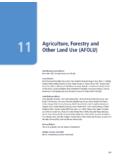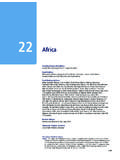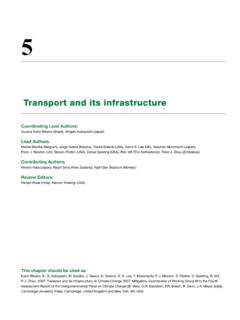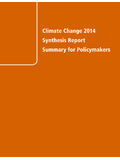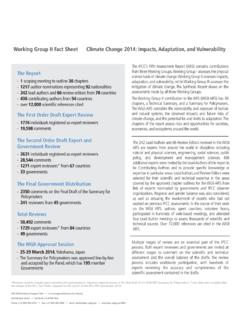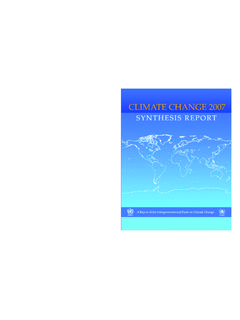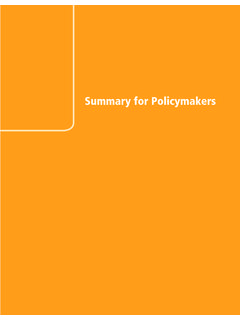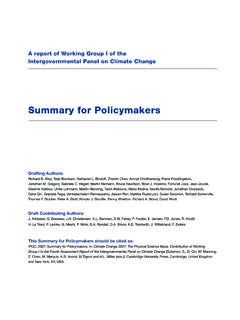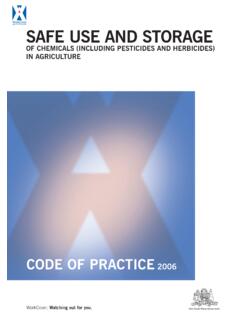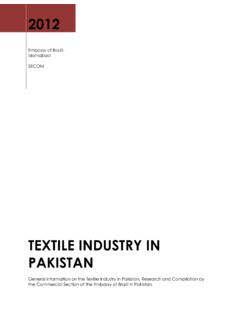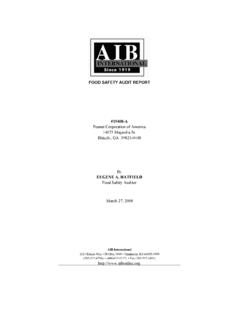Transcription of Capture of CO2 - IPCC
1 Chapter 3: Capture of CO21053 Capture of CO2 Coordinating Lead AuthorsKelly (Kailai) Thambimuthu (Australia and Canada), Mohammad Soltanieh (Iran), Juan Carlos Abanades (Spain)Lead AuthorsRodney Allam (United Kingdom), Olav Bolland (Norway), John Davison (United Kingdom), Paul Feron (The Netherlands), Fred Goede (South Africa), Alyce Herrera (Philippines), Masaki Iijima (Japan), Dani l Jansen (The Netherlands), Iosif Leites (Russian Federation), Philippe Mathieu (Belgium), Edward Rubin (United States), Dale Simbeck (United States), Krzysztof Warmuzinski (Poland), Michael Wilkinson (United Kingdom), Robert Williams (United States)Contributing AuthorsManfred Jaschik (Poland), Anders Lyngfelt (Sweden), Roland Span (Germany), Marek Tanczyk (Poland)Review EditorsZiad Abu-Ghararah (Saudi Arabia), Tatsuaki Yashima (Japan)106 IPCC Special Report on Carbon dioxide Capture and StorageContentsExECutivE SummARy introduction The basis for CO2 Capture CO2 Capture systems Types of CO2 Capture technologies Application of CO2 Capture industrial process Capture systems Introduction Natural gas sweetening Steel production Cement production Ammonia production Status and outlook Post-combustion Capture systems Introduction Existing technologies Emerging technologies Status and outlook Oxy-fuel combustion Capture systems Introduction Oxy-fuel indirect heating - steam cycle Oxy-fuel direct heating - gas turbine cycle Oxy-fuel direct heating - steam turbine cycle Techniques and improvements in oxygen production chemical looping combustion Status and outlook Pre-combustion Capture systems Introduction Existing technologies Emerging technologies Enabling technologies Status and outlook Environmental.
2 Monitoring, risk and legal aspects of Capture systems Emissions and resource use impacts of CO2 Capture systems Issues related to the classification of carbon dioxide as a product Health and safety risks associated with carbon dioxide processing Plant design principles and guidelines used by governments, industries and financiers Commissioning, good practice during operations and sound management of chemicals Site closure and remediation Cost of CO2 Capture Factors affecting CO2 Capture cost Measures of CO2 Capture cost The context for current cost estimates Overview of technologies and systems evaluated Post-combustion CO2 Capture cost for electric power plants (current technology) Pre-combustion CO2 Capture cost for electric power plants (current technology) CO2 Capture cost for hydrogen production and multi-product plants (current technology) Capture costs for other industrial processes (current technology) Outlook for future CO2 Capture costs CO2 Capture costs for electric power plants (advanced technology) CO2 Capture costs for hydrogen production and multi-product plants (advanced technology) CO2 Capture costs for other industrial processes (advanced technology) Summary of CO2 Capture cost estimates Gaps in knowledge 170 References 171 Chapter 3: Capture of CO2107 ExECutivE SummARyThe purpose of CO2 Capture is to produce a concentrated stream that can be readily transported to a CO2 storage site.
3 CO2 Capture and storage is most applicable to large, centralized sources like power plants and large industries. Capture technologies also open the way for large-scale production of low-carbon or carbon-free electricity and fuels for transportation, as well as for small-scale or distributed applications. The energy required to operate CO2 Capture systems reduces the overall efficiency of power generation or other processes, leading to increased fuel requirements, solid wastes and environmental impacts relative to the same type of base plant without Capture . However, as more efficient plants with Capture become available and replace many of the older less efficient plants now in service, the net impacts will be compatible with clean air emission goals for fossil fuel use. Minimization of energy requirements for Capture , together with improvements in the efficiency of energy conversion processes will continue to be high priorities for future technology development in order to minimize overall environmental impacts and cost.
4 At present, CO2 is routinely separated at some large industrial plants such as natural gas processing and ammonia production facilities, although these plants remove CO2 to meet process demands and not for storage. CO2 Capture also has been applied to several small power plants. However, there have been no applications at large-scale power plants of several hundred megawatts, the major source of current and projected CO2 emissions. There are three main approaches to CO2 Capture , for industrial and power plant applications. Post-combustion systems separate CO2 from the flue gases produced by combustion of a primary fuel (coal, natural gas, oil or biomass) in air. Oxy-fuel combustion uses oxygen instead of air for combustion, producing a flue gas that is mainly H2O and CO2 and which is readily captured. This is an option still under development.
5 Pre-combustion systems process the primary fuel in a reactor to produce separate streams of CO2 for storage and H2 which is used as a fuel. Other industrial processes, including processes for the production of low-carbon or carbon-free fuels, employ one or more of these same basic Capture methods. The monitoring, risk and legal aspects associated with CO2 Capture systems appear to present no new challenges, as they are all elements of long-standing health, safety and environmental control practice in industry. For all of the aforementioned applications, we reviewed recent studies of the performance and cost of commercial or near-commercial technologies, as well as that of newer CO2 Capture concepts that are the subject of intense R&D efforts worldwide. For power plants, current commercial CO2 Capture systems can reduce CO2 emissions by 80-90% kWh-1 (85-95% Capture efficiency).
6 Across all plant types the cost of electricity production (COE) increases by 12-36 US$ MWh-1 (US$ kWh-1) over a similar type of plant without Capture , corresponding to a 40-85% increase for a supercritical pulverized coal (PC) plant, 35-70% for a natural gas combined cycle (NGCC) plant and 20-55% for an integrated gasification combined cycle (IGCC) plant using bituminous coal. Overall the COE for fossil fuel plants with Capture , ranges from 43-86 US$ MWh-1, with the cost per tonne of CO2 ranging from 11-57 US$/tCO2 captured or 13-74 US$/tCO2 avoided (depending on plant type, size, fuel type and a host of other factors). These costs include CO2 compression but not additional transport and storage costs. NGCC systems typically have a lower COE than new PC and IGCC plants (with or without Capture ) for gas prices below about 4 US$ GJ-1. Most studies indicate that IGCC plants are slightly more costly without Capture and slightly less costly with Capture than similarly sized PC plants, but the differences in cost for plants with CO2 Capture can vary with coal type and other local factors.
7 The lowest CO2 Capture costs (averaging about 12 US$/t CO2 captured or 15 US$/tCO2 avoided) were found for industrial processes such as hydrogen production plants that produce concentrated CO2 streams as part of the current production process; such industrial processes may represent some of the earliest opportunities for CO2 Capture and Storage (CCS). In all cases, CO2 Capture costs are highly dependent upon technical, economic and financial factors related to the design and operation of the production process or power system of interest, as well as the design and operation of the CO2 Capture technology employed. Thus, comparisons of alternative technologies, or the use of CCS cost estimates, require a specific context to be meaningful. New or improved methods of CO2 Capture , combined with advanced power systems and industrial process designs, can significantly reduce CO2 Capture costs and associated energy requirements.
8 While there is considerable uncertainty about the magnitude and timing of future cost reductions, this assessment suggests that improvements to commercial technologies can reduce CO2 Capture costs by at least 20-30% over approximately the next decade, while new technologies under development promise more substantial cost reductions. Realization of future cost reductions, however, will require deployment and adoption of commercial technologies in the marketplace as well as sustained R& Special Report on Carbon dioxide Capture and The basis for CO2 captureThe main application of CO2 Capture is likely to be at large point sources: fossil fuel power plants, fuel processing plants and other industrial plants, particularly for the manufacture of iron, steel, cement and bulk chemicals, as discussed in Chapter 2. Capturing CO2 directly from small and mobile sources in the transportation and residential & commercial building sectors is expected to be more difficult and expensive than from large point sources.
9 Small-scale Capture is therefore not further discussed in this chapter. An alternative way of avoiding emissions of CO2 from these sources would be by use of energy carriers such as hydrogen or electricity produced in large fossil fuel-based plants with CO2 Capture or by using renewable energy sources. Production of hydrogen with CO2 Capture is included in this chapter. The possibility of CO2 Capture from ambient air (Lackner, 2003) is not discussed in this chapter because the CO2 concentration in ambient air is around 380 ppm, a factor of 100 or more lower than in flue gas. Capturing CO2 from air by the growth of biomass and its use in industrial plants with CO2 Capture is more cost-effective based on foreseeable technologies, and is included in this chapter. In an analysis of possible future scenarios for anthropogenic greenhouse-gas emissions it is implicit that technological innovations will be one of the key factors which determines our future path (Section ).
10 Therefore this chapter deals not only with application of existing technology for CO2 Capture , but describes many new processes under development which may result in lower CO2 Capture costs in CO2 Capture systemsThere are four basic systems for capturing CO2 from use of fossil fuels and/or biomass: Capture from industrial process streams (described in Section ); Post-combustion Capture (described in Section ); Oxy-fuel combustion Capture (described in Section ); Pre-combustion Capture (described in Section ).These systems are shown in simplified form in Figure Capture from industrial process streamsCO2 has been captured from industrial process streams for 80 years (Kohl and Nielsen, 1997), although most of the CO2 that is captured is vented to the atmosphere because there is no incentive or requirement to store it. Current examples of CO2 Capture from process streams are purification of natural gas and production of hydrogen-containing synthesis gas for the manufacture of ammonia, alcohols and synthetic liquid fuels.

